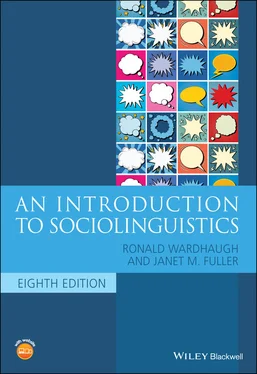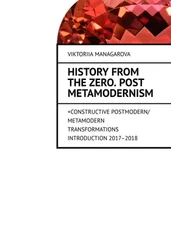1 ...7 8 9 11 12 13 ...33 As can be seen by this brief introduction, the study of sociolinguistics has grown out of an interest in the role of society in how we use language to encompass a concern for how language is part of the construction of social realities. This volume seeks to present contemporary research but acknowledge the history of the field, presenting theories and findings which contribute to our understanding of language in society in different ways.
As should now be apparent, the study of sociolinguistics is deeply concerned with aspects of scholarship which are sometimes labeled theoretical and others which are said to be applied. At the very least, sociolinguistics is a socially relevant variety of linguistics, but it is probably much more.
These chapters are organized within four general topics. However, there will be considerable moving back and forth with cross‐referencing within topics and among topics. Inter‐relationships are everywhere, and our themes will recur across the discussions of dialects, multilingualism, discourse, and social justice.
Part I, Languages, Communities, and Contexts, deals with some traditional language issues: trying to separate languages from dialects and looking at types of regional and social variation within languages ( chapter 2); trying to figure out what kinds of ‘groups’ are relevant when we study language use ( chapter 3); and looking at the role of context in language use and interpretation ( chapter 4).
Part II, Theory and Methods, looks at three broad approaches to research in sociolinguistics and how they are carried out. Chapter 5deals with variationist sociolinguistics, chapter 6ethnographic approaches, and chapter 7discourse analytic research.
Part III, Multilingual Matters, addresses both macro‐ and micro‐sociolinguistic topics in the study of multilingualism. These topics include interactional as well as societal patterns of multilingualism ( chapter 8), structural consequences of language contact ( chapter 9), and language in national, transnational, global, and digital contexts ( chapter 10).
Part IV, Sociolinguistics and Social Justice, looks into three areas of life in which sociolinguistics offers us some hope of understanding pressing problems (and which some sociolinguists argue require our deliberate intervention). Language, gender, and sexuality, one of the great ‘growth areas’ in language study, is the first of these ( chapter 11). Sociolinguistics and education is the second ( chapter 12). Language planning and policy issues, including the spread of English world‐wide and the ‘death’ of many languages, is the third ( chapter 13).
This chapter provides an introduction to the field of sociolinguistics as well as to some of the major themes that will recur throughout this textbook. We propose broad definitions for the terms ‘language’ and ‘society,’ and introduce the concept of ‘identities,’ which is central to the study of contemporary sociolinguistics. We also explore the possible relationships between language and culture, most notably the Whorfian hypothesis. Finally, we note the interdisciplinary nature of the field of sociolinguistics, as well as the breadth of topics, both macro and micro, that we will deal with in the coming chapters.
1 Look at the list of grammar rules below. Write an essay defending the use of one of these ‘incorrect’ grammatical constructions. Why do you think using these constructions is justifiable? Explain how the difference between these rules and natural speech demonstrates the difference between descriptive and prescriptive grammars. Prescriptive rules and examples:Never end a sentence with a preposition; use ‘whom’ instead of ‘who’ in object position. Example of a violation: Who did you give it to? (‘Correct’ speech: ‘To whom did you give it?’)Adverbs (words which modify a verb or adjective) should end in ‐ly (unless they are irregular, e.g., fast‐fast or good‐well). Examples of violations: Come quick! The house is on fire! (‘Correct’ speech: ‘come quickly’) That’s a real nice dress you’re wearing. (‘Correct’ speech: ‘really nice’) You read so slow! (‘Correct’ speech: ‘you read so slowly’)The verb ‘lie’ (past tense ‘lay’) means that something is in a prone position; the verb ‘lay’ (past tense ‘laid’) means that something is being put into a prone position. Examples of violations: It’s laying on the table. Just lie it down there.
2 Politically correct (PC) language. Below are some examples of so‐called PC language. Think about why these terms have been suggested, which ones have been widely adopted, and what attitudes exist toward some of these linguistic terms. What beliefs about the relationship between language and culture are reflected in the suggestion and adoption of or resistance to PC language?Firefighter (formerly ‘fireman’)Police officer (formerly ‘policeman’)People of color (formerly ‘non‐white’)Differently abled (formerly ‘disabled’)Homemaker (formerly ‘housewife’)Native Americans (formerly ‘[American] Indian’ or ‘Red Indians’)Happy Holidays (instead of ‘Merry Christmas’)
3 Language and culture: Covid terms. Below is a list of expressions used during the time of Covid‐19. Discuss how these words construct cultural norms of the time as well as illustrate linguistic creativity.‘Quarantini’: it’s a regular martini but you drink it alone at home‘Zoomtail’: similar to quarantini, except that you do it on Zoom‘Covidiot’: someone who blatantly violates social distances/hygiene protocol‘The Rona’: short version of Coronavirus‘Zoom‐ba’: same as Zumba, but on Zoom‘Zate’: Zoom + date (a date or meetup on Zoom)‘Quaran‐tan’: tanning while quarantined‘Quaranteens’: babies conceived during a quarantine, who will be teens by 2033‘Quarantime’: the era of the Covid‐19 restrictions‘Coviduation’: you may graduate but won’t participate in a graduation ceremony‘Zumping’: getting dumped on Zoom
4 Communicative competence. Look at the following joke about British sayings and what they really mean. Discuss how this depiction of cross‐cultural miscommunication illustrates the concept of communicative competence.WHAT THE BRITISH SAYWHAT THE BRITISH MEANWHAT FOREIGNERS UNDERSTANDI hear what you sayI disagree and do not want to discuss it furtherHe accepts my point of viewWith the greatest respectYou are an idiotHe is listening to meThat’s not badThat’s goodThat’s poorThat is a very brave proposalYou are insaneHe thinks I have courageQuite goodA bit disappointingQuite goodI would suggestDo it or be prepared to justify yourselfThink about the idea, but do what you likeOh, incidentally/by the wayThe primary purpose of our discussion isThat is not very importantI was a bit disappointed thatI am annoyed thatIt doesn’t really matterVery interestingThat is clearly nonsenseThey are impressedI’ll bear it in mindI’ve forgotten it alreadyThey will probably do itI’m sure it’s my faultIt’s your faultWhy do they think it was their fault?You must come for dinnerIt’s not an invitation, I’m just being politeI will get an invitation soonI almost agreeI don’t agree at allHe’s not far from agreementI only have a few minor commentsPlease rewrite completelyHe has found a few typosCould we consider some other optionsI don’t like your ideaThey have not yet decidedSource: Translation table explaining the truth behind British politeness becomes internet hit, by Alice Philipson, The Telegraph, September 1, 2013. © 2013, Telegraph Media Group Limited.
1 Bayley, Robert, Richard Cameron, and Ceil Lucas (eds.) (2013). The Oxford Handbook of Sociolinguistics. Oxford: Oxford University Press.
Читать дальше




![Andrew Radford - Linguistics An Introduction [Second Edition]](/books/397851/andrew-radford-linguistics-an-introduction-second-thumb.webp)







